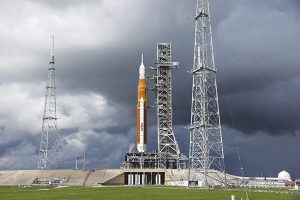Bloomberg
Nasa is standing down from its Artemis I mission to the moon next week, as a tropical storm off the coast of South America creeps towards Florida and the agency’s launch site for the Space Launch System rocket.
The US space agency said it will decide whether to roll the rocket and spacecraft back from the launch pad to its
primary hangar, the Vehicle Assembly Building.
“During a meeting, teams decided to stand down on preparing for the Tuesday launch date to allow them to configure systems for rolling back the Space Launch System (SLS) rocket and Orion spacecraft to the Vehicle Assembly Building,†Nasa said in a blog post.
The decision to delay comes after Nasa completed a key fuelling test on September 21 of its Space Launch System rocket, the massive vehicle that will send an uncrewed capsule around the moon. The fuelling test was meant to determine if Nasa had successfully fixed a leak that stymied an attempt to launch the rocket on September 3.
During the test, two hydrogen leaks emerged as engineers fuelled the SLS rocket, as well as other technical issues. While one of the leaks eventually abated after some troubleshooting, the second leak that cropped up later in the test would have prevented a launch if Nasa had hoped to fly that day.
Despite the troubles, Nasa was able to completely fuel the rocket, and the agency claimed that the mission team had met all of the objectives for the test.
“It was a very successful day,†John Blevins, the chief engineer for the SLS rocket at Nasa, said during a press conference. “I think all the secondary objectives were met, not just the primary objectives.â€
Nasa had held out hope on Friday that a launch attempt was possible for September 27 despite forecasts showing the newly formed Tropical Depression Nine heading toward Florida. The depression strengthened into a tropical storm late Friday.
“It’s not even a named storm,†Tom Whitmeyer, Nasa’s deputy associate administrator for common exploration systems development, said during the press conference. “It’s Tropical Depression Number Nine. It’s very early in.â€
The SLS rocket is designed to handle wind gusts as strong as 74 knots at the launchpad. It takes Nasa roughly three days to prepare and return the SLS back to the Vehicle Assembly Building.
 The Gulf Time Newspaper One of the finest business newspapers in the UAE brought to you by our professional writers and editors.
The Gulf Time Newspaper One of the finest business newspapers in the UAE brought to you by our professional writers and editors.
